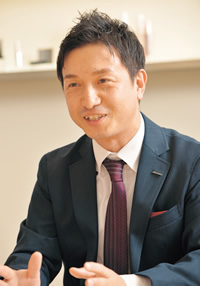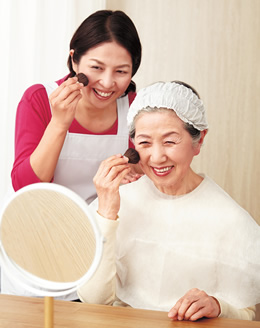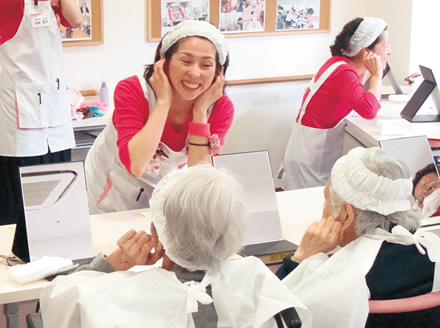niponica is a web magazine that introduces modern Japan to people all over the world.
2018 NO.23
Style in Japan

From Glamour to Vitality
Cosmetic therapy for elderly people in long-term care
“Women in their later years can really brighten their days by having a little fun with beauty products,” says Ikeyama Kazuyuki. (Photo: Kohara Takahiro)
Keeping cosmetic habits as one grows old may lead to better physical and mental health. Data shows this is attracting attention in Japan, where the population is aging.
Research linking cosmetic use with improvements in mental alertness and muscular strength is making strides thanks partly to Ikeyama Kazuyuki of Shiseido Company, Limited.
“From our research results, we’ve learned that when women apply makeup, the motion of their fingers, hands and arm muscles uses two to three times more energy than when they eat a meal. We tell medical staff that when women in long-term care apply makeup and have fun looking after their appearance, there can be a rehabilitation effect without them realizing it. Professionals had tended not to give much thought to makeup until they heard that, but now it has caught their attention.”
Drawing from his own experience as a personal care worker, and the positive results of personal beauty classes held by Shiseido over the years, Ikeyama has developed a cosmetic therapy program that is being introduced by long-term care facilities. “We saw that even people suffering from a fair amount of dementia began looking more optimistic, and increased their level of independence.” This is just one of the upbeat results he says they are finding.
Today, more local governments are starting to offer cosmetic therapy programs, not only to give enjoyment through beauty products but also to slow the onset of the need for extra care and extend healthy lifespans (the length of time one lives a satisfying life without a major health problem).
“Taking care of one’s skin and dressing well are good for both the mind and the body. I’m keen on getting more people to realize this, to take up the slogan ‘Let’s stay interested in our appearance,’ which can translate into aiming for a healthy lifespan.”
Ikeyama’s eyes light up as he says this.
A scene at a personal beauty class for the elderly. Putting on makeup is about more than good looks. It can also increase mental alertness, physical fitness and everyday life skills.
Beauty for Men, Too
Photos: Ito Chiharu, courtesy of Aflo
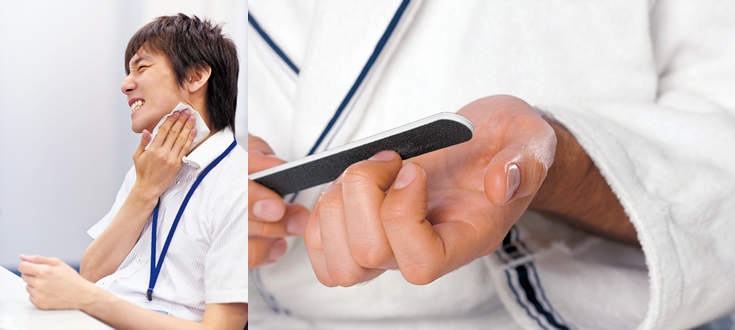
Although beauty standards for men in Japan are much broader and more varied today than they have been in the past, the ideal male beauty is still rooted in the traditional Japanese value of cleanliness. Grooming for men has moved beyond the conventional shaving and hair styling to include many different types of cosmetic products formulated specifically for men. More and more Japanese men use specialized cleansers to wash their faces, as well as skincare products to soothe rough skin or reduce oiliness, concealers to cover blemishes and spots, sunscreen to protect against UV rays for outdoor sports, and deodorants and antiperspirant sheets to prevent sweatiness and body odor.
Salons have also responded to demand from male customers for hair treatments, body and facial hair removal, and properly groomed nails by offering beauty treatments and manicures especially for men.
Japanese people do not use perfume and cologne in the way most Westerners do, because the ideal in Japanese culture is to eliminate odors rather than add scent. This is equally true of men’s grooming, and most of the new techniques and products in the market are designed to keep men clean and odor-free.
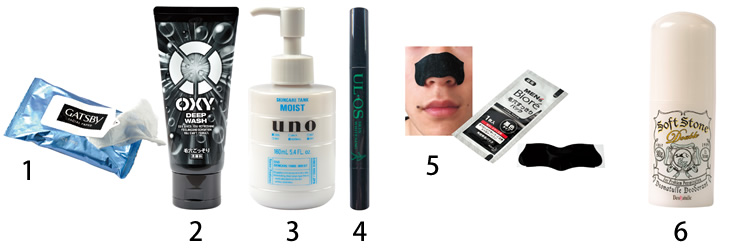
1. Cooling antiperspirant sheets. 2. Cooling face cleanser. 3. Moisturizer containing hyaluronic acid. 4. Pen-style beauty lotion to reduce spots and freckles. 5. Nose pack for clearing pores. 6. Roll-on antiperspirant. The most popular men’s beauty products are easy to carry on the go in a pocket or bag.







